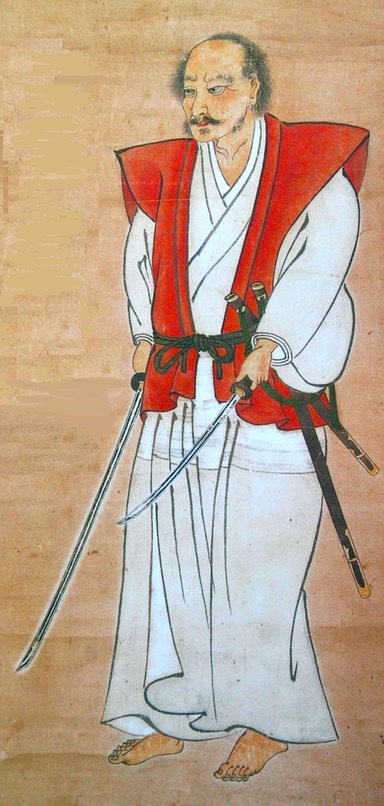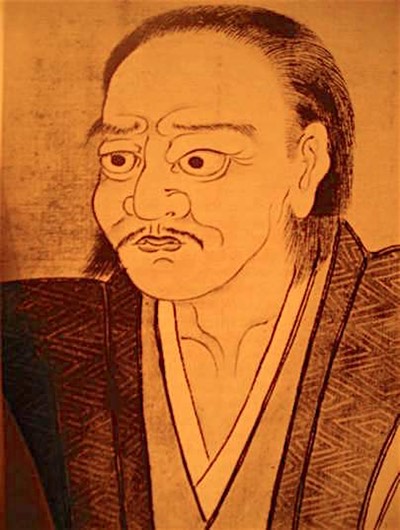The most widely known image of Musashi that has come down to us is a warrior somewhat advanced in years, wearing long white robes and red haori and holding his iconic long and short swords in a somewhat passive stance, as if patiently awaiting his opponent’s opening attack, or maybe even just for the purpose of posing for his painting. Executed in color on paper in a detailed, realistic style, it is now kept in the Shimada Museum of Art in Kumamoto.
Though the painting is attributed to Musashi himself, it might also have been painted at a later date. In that case, its painter might have based his depiction on what he had read in Tanji Hōkin's Bushū denraiki, which is one of the few documents to describe at length Musashi’s physical appearance and clothing habits:
繻子の小袖に紅裏をして、足の甲に垂る程長きを着し、繻子純子又は紙子等の胴肩衣を着し、刀脇指は木柄にて、赤金拵なり。
He used to wear a long satin undergarment lined with red silk that would reach down to the arches of his feet. On top of this he would wear a sleeveless jacket made of satin, damask, or just hemp. The hilts of his sword and daggers were made of wood decorated with copper.
However, it is just as likely that Hōkin had seen the painting whilst visiting Kumamoto and based his description on Musashi’s self-portrait.
Sadly, there are no contemporary images of Musashi as a young man, let alone in his youth, though it is safe to assume that the hair on his forehead would have been shaven at the time he underwent his so-called genpuku, the Shinto ceremony marking a boy’s entry into adult life, usually before the age of twenty (see Musashi’s Names). However, it seems that later in life he took up the habit of letting his hair grow—so much so that, according to the Bushū denraiki, “his hair would grow down to his belt, although when he grew old it merely reached his shoulders.”
The Watanabe kōan taiki-wa, the biography of the swordsman-adventurer Watanabe Kōan, who might have met Musashi in 1637 during the suppression of the Shimabara Rebellion (see Musashi’s Battles), is one of the few other records to mention Musashi’s physical habits, especially where it concerned his hygiene:
洗足行水を嫌いて一生沐浴する事なし。外へ跣にて出、よごれ候えば是を拭せ置く也。それゆえ衣服よごれ申す故、色目を隠すためにびろうど両面の衣服を着る。
Musashi hated to wash his feet or clean himself with water, and never once throughout his life took a bath. Going out on bare feet he would merely wipe them, even if they were soiled. Moreover, since his clothes were dirty, he would wear a velvet coat to disguise the stains.
In a culture obsessed with physical cleanliness Musashi’s habit of washing himself with a wet cloth becomes less of an enigma when we realize that from an early age he had suffered from eczema. Eczema is exacerbated by dryness of the skin and those who suffer from this affliction often find relief in keeping their skin moist. This still does not seem to explain why Musashi should have shied away from taking baths, but baths in Japan are traditionally taken very hot, which, though providing some instant relief, tends to dissolve the natural oils contained in one’s skin, thus resulting in an even dryer skin.
Any queries of remarks? Launch or join a discussion at our new FORUM

